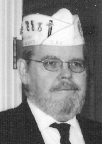 | Frank Bergquist graduated from Eddyville, IA, high school in 1958. After graduation, he entered the Army, serving 20 years in Missouri, Maryland, New Mexico, Germany, Iowa, Turkey, Kansas, S.E. Asia, and finally retiring in 1978 in Louisiana. Before retiring, Frank was assigned as an ROTC instructor at WSU and Kemper Military School until 1974. In 1978 he served as the Non-Commissioned officer in charge of operations at Fort Polk, LA. He has served as the Veterans Counselor (DVOP) with the Kansas Job Service Center National Service Office, with the Disabled American Veterans at the VA Regional Office in Wichita; Veterans Employment and Training Coordinator with the US Dept. of Labor at Ft. Riley, KS; Service Coordinator with Cerebral Palsy Research Foundation; Dept Adjutant-Treasurer and the Dept. Executive Director Dept. of Kansas Disabled American Veterans; and past President of the Wichita Civil War Round Table. Currently he is doing graduate work as an instructor in Genealogy and Military History at Wichita State and Kansas State Universities, and is the CEO for the Disabled American Veterans Thrift Stores in Wichita, KS. Bergquist has an AA from Kemper Military School and College from Boonville, MO. and a BGS from Wichita State University. He can be reached by telephone at 316-262-6501. He is located at 926 N. Mosley Wichita 67214. |
Veteran Affairs
2006-05-01 16:01:00
Wars and scars
: What is the History of the Disabled American Veterans?
ANSWER: The beginnings of Disabled American Veterans followed the wake of World War I, when thousands of American doughboys came home to an America that was not prepared to care for the carnage of war. More than 4.7 million Americans served, 53,500 were lost in combat. Accidents and illnesses (mostly from the deadly Spanish flu pandemic) took the lives of 63,000. More than 200,000 soldiers were wounded during the war.America was not prepared to go to war or face its aftermath, especially caring for the sick and wounded. Months after returning home, half of the 4 million soldiers were released from military service. With the country drained of its economic resources due to the war, there was little funding available to help war veterans in search of employment and medical care. Within a year, 4 million Americans were jobless, broke and past hope. Recession and unemployment crippled the American economy. As a result, veterans were left to fend for themselves, especially those who were disabled. Jobs were almost nonexistent for these men. The few government agencies charged with responsibility for veterans were under funded, often working at cross-purposes and required veterans seeking help to complete an abundance of bureaucratic paperwork, much to the dismay of veterans. Many gave up, finding themselves having to look to each other for help. It was in this environment that groups of disabled veterans gathered together across the country, some for social purposes, others working to raise money and create jobs for their comrades.His tireless efforts in this endeavor earned him the title of the “Father of the DAV.” The history of the DAV is the story of victory and defeat, success and near disaster, but always the commitment to build better lives for disabled veterans and their families. By holding to this single purpose the DAV is today the finest veterans service organization in the world—offering free services to millions of veterans each year. It’s often been said that “what is past, is prologue.” For the Disabled American Veterans, the outstanding achievement of its past 85 years is a remarkable testimonial for its future.The 1.3 million-member Disabled American Veterans, a non-profit organization founded in 1920 and chartered by the U.S. Congress in 1932, represents this nation’s disabled veterans. It is dedicated to a single purpose: building better lives for our nation’s disabled veterans and their families. For more information, visit the organization’s Web site at www.dav.org.


